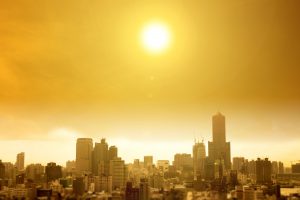Heat in Urban Asia: Past, Present and Future
September 26, 2021

Singapore’s first Climate Rally was held on 21st September 2019 at Hong Lim Park. The event attracted more than 1,700 participants who called for the Singapore government to take action to tackle biodiversity loss and climate change. Participants called for the government to signal a credible commitment towards tackling climate change through higher carbon taxes for greenhouse gas emissions and tightened regulatory measures.
Throughout Asia, heatwaves are causing widespread public health and economic problems. With Climate Change, the frequency of heatwaves and average global temperatures are expected to increase at alarming rates. Many countries are anxious to find better solutions to mitigate the heat.
The project ‘Heat in Urban Asia: Past, Present and Future’, led by Associate Professor Gregory Clancey (NUS History and Asia Research Institute), investigates the problem of urban heat in Singapore, Wuhan, Delhi, and Hong Kong. A multidisciplinary team comprising of historians, climate scientists, geographers, and sociologists spearheads the study via the following themes. Firstly, ‘Taking the City’s Temperature’ examines the quantitative record of historic temperatures. Through detailed archival research, the research team intends to uncover temperature datasets that extend further back than what climatologists currently use. Apart from quantitative records, qualitative historical sources and oral histories will be incorporated into the analysis. For instance, the team will inspect whether Japanese archives had recorded any experiences of heat during their occupation of Singapore.
The second theme, ‘Living with Heat’, studies how Asians in urban areas deal with daily heat exposure and how its effects may be suffered disproportionately by poverty-stricken and vulnerable groups at their residences and workplaces. It also examines the past and present designs and planning of the built environment to determine whether it helped or hindered the Urban Heat Island (UHI) effect. UHI refers to an urban area which experiences a higher average temperature when compared to its (non-urban) surroundings during the day. This usually occurs as urban surfaces like asphalt tend to absorb more heat. Heat is easily retained in urban areas as the presence of tall buildings inhibit the cooling effect of wind. Additionally, increased pollutants in urban areas coupled with waste heat from automobiles and air-conditioning also contribute to the UHI effect. Throughout history, the four cities in this study have employed different techniques to combat heat. The researchers aim to consolidate and reveal the varying successes and failures of the four cities to better mitigate the effects of heat in the future.
The third and final theme, ‘Disastrous Heat’, explores what happens when temperatures rise to dangerous levels. The intensity and frequency of heatwaves is increasing with climate change, causing contemporary social, health, and economic problems for urban dwellers. It seeks to build up multidisciplinary knowledge to reduce the impact of heatwaves and enhance disaster responses to heatwaves.
‘Heat in Urban Asia’ initiates a new approach to studying urban heat by integrating knowledge from diverse backgrounds. If successful, incorporating such analysis will offer a different solution to mitigating the effects of heat, assisting policymakers and relief agencies in reducing the effects of heatwaves and high temperatures in the future. The researchers plan to disseminate their data and results through an open-source web portal to build public knowledge, and to establish a regional centre on heat research in Singapore.
Read more about the project in NUS News.
